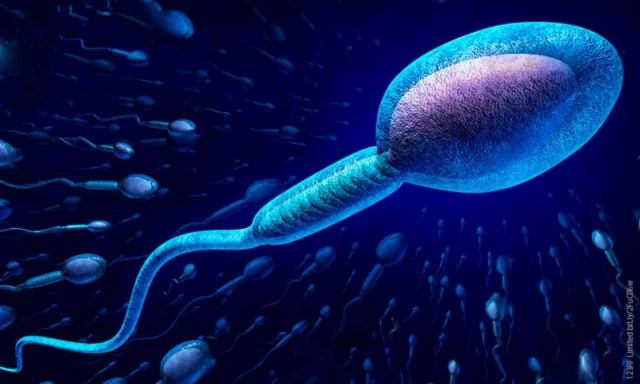American anthropologist Emily Martin was one of the first to draw attention to the language used to talk about fertilization, and to see how cultural values in general creep into the way scientists describe their discoveries about the natural world. Many of us have learned about the human fertilization process as if it were a fable or a fairy tale.
Precisely, a story in which millions of tadpoles with gigantic heads and thin tails swim frantically in a hostile environment with a single objective: to reach the egg that patiently awaits their arrival. The fastest and most agile sperm that manages to complete this marathon feat wins the prize. It conquers the ovum, penetrates it, and thus an embryo begins to take shape.
Words more, words less, this is the narrative that usually accompanies the fertilization process. However, this story that presents the sperm as an active agent in opposition to the egg, whose role is assumed to be passive, does not correctly reflect how this event unfolds. Both—and especially the female reproductive tract—play a crucial role in reproduction.
Checkpoints
The story begins with ejaculation. Once it is produced, tens of millions of sperm are deposited in the vagina (it is estimated that an average ejaculate may contain around 250 million sperm).
Once there, they must first overcome the barrier of the cervix, Kristin Hook, an evolutionary biologist from the science, technology assessment and analysis team of the United States Government Accountability Office, explains to BBC Mundo. “Within the reproductive tract there are a series of what I would call, from a female point of view, ‘checkpoints’ that the sperm must pass through to reach the site of fertilization, which is quite far from the point of entry».
Unless the sperm are in good shape (most have DNA damage or other defects), they will not be able to pass through this barrier. “This is a very important selection process”, says Daniel Brison, scientific director of the Department of Reproductive Medicine at the University of Manchester in the UK. “Out of the several million sperm that are produced in an ejaculation, only a few hundred will reach the egg”.
Contractions and secretions
However, sperm cannot reach the end of the fallopian tubes (also called oviducts) on their own, where conception occurs, because they are not strong enough. The movement that the tail of the spermatozoon makes to the sides has a force ten times greater than that which it makes forward. “Sperm do not swim, but are mostly propelled by contractions of the uterus“, explains Brison. “Swimming is only a minimal part and that only happens when they reach the egg”, adds the researcher.
On the other hand, the secretions inside the uterus and the oviducts can also modify the trajectory of the sperm, promoting or preventing their movement, altering their consistency. In short, “it is the mechanical action of the oviduct, as well as its chemistry – whether it has a salty or viscous fluid, or a certain type of pH– both controlled by the female reproductive tract, which will regulate how conception will occur. That is to say: which spermatozoon is going to be allowed to meet the ovule”,Virgina Hayssen, professor of Biology at Smith College in the USA, tells BBC Mundo.
“The pH of the vaginal environment is lower than what would be ideal for sperm, but this acidity is essential (…) for a series of changes to occur in the membranes and enzymes of the sperm, which will allow them to acquire greater mobility, a faster metabolism, and also the ability to penetrate the outer protein layer of the oocyte (the immature egg) which is very difficult to penetrate”, Filippo Zambelli, a researcher at the Eugin Group in Spain, dedicated to assisted reproduction, explains to BBC Mundo.
Some researchers maintain that the female orgasm may also contribute to this upward journey of the sperm by causing internal muscle contractions, but others point out that more studies are needed to confirm this hypothesis.

A shorter trip
The egg, meanwhile, is not passively awaiting the arrival of the winning sperm. Although the egg does not have the ability to move on its own, the cilia (a kind of hair) inside the tubes help it to move downwards in a short journey that begins in the ovary. “The egg moves along the fallopian tube towards the uterus, secreting so-called chemoattractants (or chemoattractants), chemical molecules that attract sperm and actively guide them towards it”, says Zambelli. The egg can use these molecules “to attract or repel, as well as to modify where each sperm goes”, Hayssen completes.
Describing the encounter between the sperm and the egg as an act of penetration also does not accurately portray what happens, since the egg is the one that attracts the sperm and controls —in most cases— that a single sperm is the one that fuses with the. The union is actually a process of mutual interactions where both parties play an active role and where a series of receptors and chemical substances are involved.
Hostile environment
Is the environment in which the sperm develops really hostile, as they say? In Hayssen’s opinion, this is again an unfortunate adjective because it describes the event from a male point of view. “It is hostile if you see it as a competition and not collaboration”, he says. “The environment is promoting the generation of viable offspring, so it is not hostile in terms of the goal, which is ‘we have a baby at the end of all this’ “.
“The environment is trying to produce the best possible baby, one that can produce as many offspring as possible, so the environment can never be hostile to that.” If you look at it “from the female point of view, the uterus is doing exactly what it needs to do to benefit the mother in getting the best offspring”.
New technologies but old ideas
While some details of the conception process have been known relatively recently thanks to advancing scientific research, much of the information, such as the minor importance of sperm motility, has been known for decades.
American anthropologist Emily Martin was one of the first to draw attention to the language used to talk about fertilization, and to see how cultural values in general creep into the way scientists describe their discoveries about the natural world. Her academic text —published in the early 1990s— which analyzes in detail the gender stereotypes hidden in scientific texts on the subject, became a point of reference for feminism.
The experts consulted by BBC Mundo also point to the lack of female representation in science as well as in decision-making areas in education. “The continuing lack of representation in science of people with different perspectives is going to influence the kinds of questions you ask and the explanations you’re going to find”, says Kristin Hook.
Hayssen emphasizes the need to question the terminology we use and use neutral language to talk about it: we should use “conception and not fertilization”, for example. But removing gender bias in our understanding of the mechanism of conception is not just necessary to correct scientific misinformation and accurately describe biological processes. It is also a fundamental step to improve existing assisted fertility treatments and make way for new technologies.

